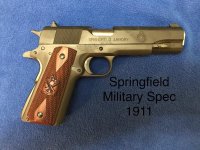Ziggy2525
Member
- Joined
- Jan 10, 2016
- Messages
- 1,530
- Reaction score
- 3,247
I've been considering getting a full size 1911 for range use and to shoot in the local IDPA matches every now and then. Not looking for anything fancy, just a 1911 that's functional and reliable out of the box. Doesn't have to be "original GI."
I've been searching/researching here and on a couple other forums. One question I haven't been able to answer is about series 70 vs series 80. I think I understand difference between them, but I'm not sure I understand if the difference actually matters.
Are the series 70 models not drop safe because they don't have the trigger actuated firing pin safety? Are the series 80 models terrible shooters or maintenance nightmares because of the extra components?
Thanks.
I've been searching/researching here and on a couple other forums. One question I haven't been able to answer is about series 70 vs series 80. I think I understand difference between them, but I'm not sure I understand if the difference actually matters.
Are the series 70 models not drop safe because they don't have the trigger actuated firing pin safety? Are the series 80 models terrible shooters or maintenance nightmares because of the extra components?
Thanks.

